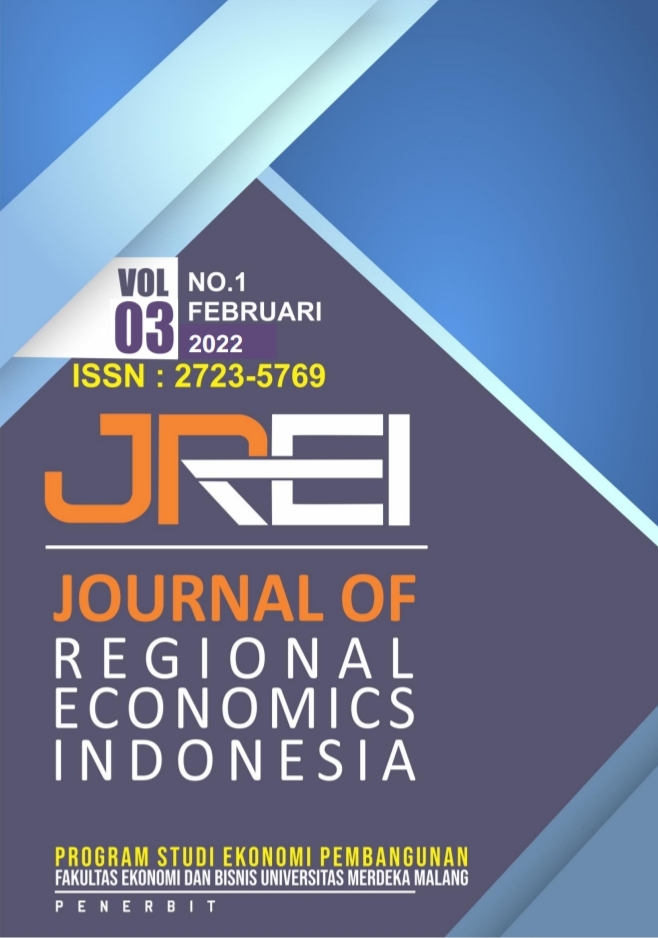Faktor Pendorong dan Penarik Migrasi Penduduk di Perkotaan (Kasus Migran Atambua di Kota Malang)
DOI:
https://doi.org/10.26905/jrei.v3i1.8010Keywords:
Push Factor, Pull Factor, Migration, Atambua MigrationAbstract
This study examines the push and pull factors of Atambua migrants in Malang City in the period 1985-2020. This study uses a migration approach that is viewed from two main factors, namely: (i) the push factor from the area of origin; and (ii) the pull factor owned by the destination area. The research location is Malang City as one of the centers of economic activity in East Java. The method used is descriptive narrative, where the data collection uses a questionnaire instrument. This study found that Atambua migrants chose Malang City because of their family and government support, because the majority of Atambua migrants moved to Malang City as a background to pursue higher education. From the driving side, the Atambua area in East Nusa Tenggara (NTT) still has various infrastructure limitations, especially the lack of educational facilities. This finding strengthens the proposition that the existence of basic infrastructure such as educational facilities is one of the strong driving factors in increasing the attractiveness of population migration.Downloads
References
Adioetomo SM dan Samosir OB. 2010. Dasar-dasar Demografi edisi 2. Jakarta : Penerbit Salemba Empat.
D Elfranita, B Asyik, Z Zulkarnain- Jurnal Penelitian Geografi, 2013-jurnal.fkip.unila.ac.id
Lee, E. S. 1966. “ A Theory of Migration†dalam Demography vol. 3, no.1 1966 pp 47-57.
Lee, E. S. 2000. Suatu Teori Migrasi. Yogyakarta : Pusat Penelitian dan Kependudukan Universitas Gadjah Mada.
Mantra, I. B. 1985. Pengantar Studi Demografi. Yogyakarta : Pustaka Pelajar.
Mantra, I. B. 1991. Mobilitas Penduduk Sirkuler: Dari Desa Ke Kota di Indonesia. Yogyakarta: Pusat Studi Kependudukan dan Kebijakan UGM.
Mantra, IB 2000. Demografi Umum. Yogyakarta : Pustaka Pelajar.
Munir, Rozy. 2000. “Migrasiâ€, Dasar-dasar Demografi edisi 2000. Lembaga Penerbit UI: Jakarta Gujarati, Damodar. 2009. Basic Econometrics. The Mc Grow Hill Companies Inc. New York
Nazsir, M . 1988. Metode Penelitian.Jakarta : Ghalia Indonesia.
Niari R, B Asyik, Z Zulkarnain-Jurnal Penelitian Geografi, 2013-jurnal.fkip.unila.ac.id
Pemerintah Kota Malang. 2020. http://malangkota.go.id/sekilas-malang/geografis/.
Ravenstein, 1985. Teori Migrasi. Pusat Penelitian Kependudukan UGM. Yogyakarta.
Sukmaniar, S., Romli, M. E., & Sari, D. N. 2018. Faktor Pendorong dan Penarik Migrasi pada Mahasiswa dari Desa untuk Kuliah di Kota Palembang. Demography journal of sriwijaya
Sugiono. 2010. Metode Penelitian Pendidikan Pendekatan Kuantitatif, Kualitatif, Dan R&D.Bandung : Alfabeta.
Torado, Michael P. dan Stephen C. S. 2000. Pembangunan Ekonomi di Dunia Ketiga Edisi Ketujuh.Jakarta : Erlangga.
Downloads
Published
Issue
Section
License
License JREI: Journal of Regional Economics Indonesia, University of Merdeka Malang is licensed under Creative Commons Attribution Attribution-NonCommercial-NoDerivatives 4.0 International License.
JREI: Journal of Regional Economics Indonesia, University of Merdeka Malang is licensed under Creative Commons Attribution Attribution-NonCommercial-NoDerivatives 4.0 International License.
Copyright
Authors who publish with this journal agree to the following terms:
- Authors retain copyright and grant the journal right of first publication with the work simultaneously licensed under a Creative Commons Attribution Attribution-NonCommercial-NoDerivatives 4.0 International License that allows others to share the work with an acknowledgment of the work's authorship and initial publication in this journal.
- Authors are able to enter into separate, additional contractual arrangements for the non-exclusive distribution of the journal's published version of the work (e.g., post it to an institutional repository or publish it in a book), with an acknowledgment of its initial publication in this journal.
- Authors are permitted and encouraged to post their work online (e.g., in institutional repositories or on their website) before and during the submission process, as it can lead to productive exchanges and earlier and greater citation of published work (See The Effect of Open Access).




